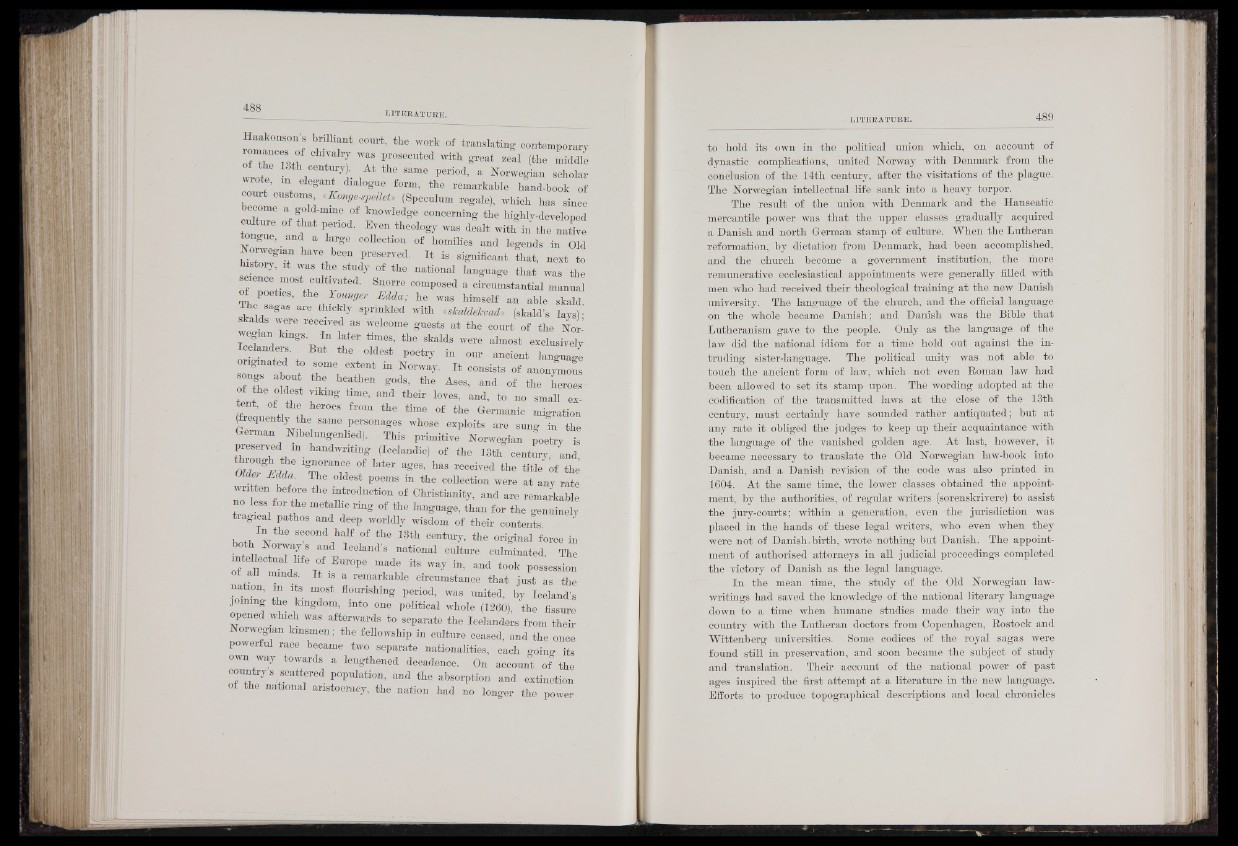
Haakonson s brilliant court, the work of translating contemporary
o “ B M M i Prosecuted with great zeaf (the middle
ot the 13th century). At the same period, a Norwegian scholar
wrote, g elegant dialogne form, the remarkable hind-book of
court customs «Konge-speileh (Speculum regale), which has since
culture ^0wledge BBB B tighly-developed
ulture of that penod. Even theology was dealt with in the native
tongue, ^ and a large collection of homilies and legends in Old
Norwegjan have been preserved. I t I significant that, next to
. J ’ ^ aS 7 of tlie national language that was the
oCmnce most cultivated. Snorre composed a circumstantial manual
p i s , e Younger Edda; he was himself an able skald
The sagas are thickly sprinkled with «skaldekvad» (skald’s lays)-’
skalds were received as welcome guests at the-court of the Norwegian
kings. -In later times, the skalds were almost exclusively
celanders But the oldest poetry in our ancient language
originated to some extent in Norway. I t consists of anonymous M m H hrtlien g°AS' B AseS’B B B Bi and their and of heroes- to no small exfZ
n M M " °m I time of I Germanic migration
frequently the same personages whose exploits are sung in the
German Nibelungenlied). This primitive Norwegian poetry is
preserved m handwriting (Icelandic)of the 13th century,- and BBi BB °f kter ag6S’ B rece™d ^ e title of the Oder Edda. The oldest poems in the collection were at any rate
1 I of Christianity, and are remarkable
no less for the metallic nng of the language, than for the genuinely
t r a g i c a l p a th o s a n d d e e p w o r ld ly w isd om o f th e i r c o n te n ts
both No™ S6C01ldi f | !te 13th CeaW , the original force in
. L ay S a eland 8 national culture culminated. The
m t^ec tua l hfe of Europe made its way in, and took possession
of all minds I t is a remarkable circumstance that just as the
nation, in its most flourishing period, was united, by Iceland^
joining the kingdom, into one political whole (1260), the fissure
opened which was afterwards to separate the Icelanders from their
orwegian kinsmen; the fellowship in culture ceased, and the once
powerful race became two separate nationalities, each goine- its
own way towards a lengthened decadence. On account of the
country « scattered population, and the absorption and extinction
of the national aristocracy, the nation had no longer the power
to hold its own in the political union which, on account of
dynastic complications, united Norway with Denmark from the
conclusion of the 14th century, after the visitations of the plague.
The Norwegian intellectual life sank into a heavy torpor.
The result of the union with Denmark and the Hanseatic
mercantile power was that the upper classes gradually acquired
a Danish and north German stamp of culture. When the Lutheran
reformation, by dictation from Denmark, had been accomplished,
and the church become a government institution, the more
remunerative ecclesiastical appointments were generally filled with
men who' had received their theological training at the new Danish
university. The language of the church, and the official language
on the-whole became Danish; and Danish was the Bible that
Lutheranism gave to the people. Only as the language of the
law did the national idiom for a time hold out against the intruding
sister-language. The political unity was not able to
touch the ancient form of law, which not even Homan law had
been allowed to set its stamp upon. The wording adopted at the
codification of the transmitted laws at the close of the 13th
century, must certainly have sounded rather antiquated; but at
any rate it obliged the judges to keep up their acquaintance with
the language of the vanished golden age. At last, however, it
became necessary to translate the Old Norwegian law-book into
Danish, and a Danish revision of the code was also printed in
1604. At the same time, the lower classes obtained the appointment,
by the authorities, of regular writers (sorenskrivere) to assist
the jury-courts; within a generation, even the jurisdiction was
placed in the hands of these legal writers, who even when they
were not of Danish.birth, wrote nothing but Danish. The appointment
of authorised attorneys in all judicial proceedings completed
the victory of Danish as the legal language.
In the mean time, the study of the Old Norwegian law-
writings had saved the knowledge of the national literary language
down to a time when humane studies made their way into the
country with the Lutheran doctors from Copenhagen, Rostock and
Wittenberg universities. Some codices of the royal sagas were
found still in preservation, and soon became the subject of study
and translation. Their account of the national power of past
ages inspired the first attempt at a literature in the new language.
Efforts to produce topographical descriptions and local chronicles